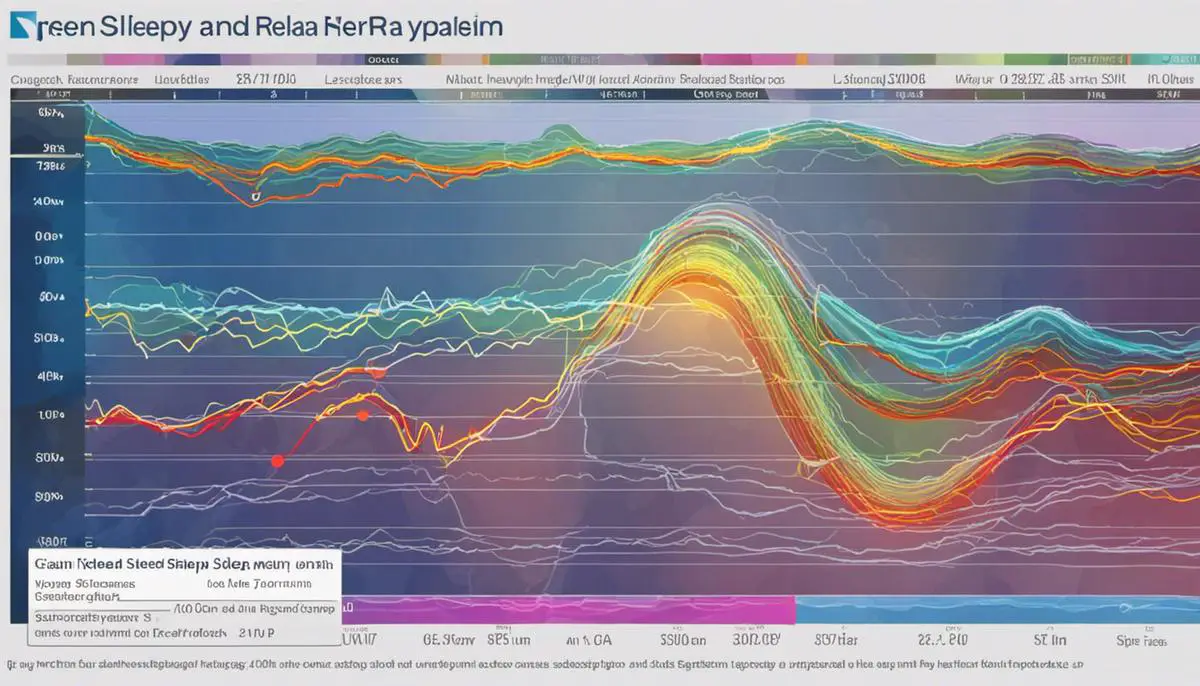Exploring the intriguing intersection between pharmacology and neurobiology, this comprehensive review delves into the relationship between a widely-used antidepressant, Lexapro (chemical name: escitalopram), and a significant phase of our sleep cycle, Rapid Eye Movement (REM) sleep. Topics ranging from the biochemistry of Lexapro and its role in enhancing serotonin availability, to the profound understanding of REM sleep and its critical part in memory consolidation and cognitive functions, are elaborated upon. Following this foundational knowledge, a detailed exploration into how Lexapro possibly influences REM sleep parameters, and any ensuing REM sleep disorders or variations, forms a significant part of the discussion. This review aims to provide a holistic understanding of this subject, underpinned by scrutinizing existing research in a manner accessible to the general public.
Understanding the Biochemistry of Lexapro
Unravelling the Mechanistic Underpinnings of Lexapro’s Action in the Human Brain
Escitalopram, marketed under the brand name Lexapro, is a widely prescribed medication for depression and anxiety, which are major health challenges in present-daysociety. Much of Lexapro’s success in clinical applications can be attributed to its chemically intricate functionalities, yet the precise mechanisms by which Lexapro influences the human brain remain largely enigmatic. In order to demystify this topic veiled in scientific intrigue, it is crucial to venture into the depths of neurobiology, specifically, the dynamics of serotonin reuptake and selective serotonin reuptake inhibitors (SSRIs).
Lexapro belongs to a class of antidepressants known as SSRIs. These function by increasing the level of serotonin, a neurotransmitter that mediates mood, in the brain. By nature, serotonin is produced in the brain to transmit signals between neurons, after which it is reabsorbed by cells—a process known as reuptake. Occasionally, the reuptake process may occur too prematurely, leading to inadequate serotonin levels and potentially resulting in depression or anxiety. Lexapro operates by blocking this premature reuptake, thereby increasing serotonin concentration and enhancing its overall effect.
Nevertheless, the transaction isn’t quite as straightforward as it initially appears. Lexapro acts on what is known as the presynaptic neuron, the neuron from which serotonin originates. It binds to the serotonin transporter—essentially a molecular gatekeeper—that controls serotonin reuptake. That binding impedes the transporter’s function, effectively prolonging the amount of time for which serotonin exists in the synaptic cleft, or the tiny space between neurons.
What sets Lexapro apart from other SSRIs lies in its enhanced efficiency and reduced side effects, earned by its molecular subtleties. Lexapro, or more technically, escitalopram, is a stereoisomer—a mirrored version—of citalopram. This stereochemistry enables it to bind more effectively to the serotonin transporter, enhancing its inhibitory effect. As a result, lower doses of Lexapro can accomplish what higher doses of other SSRIs might, thereby reducing unwanted side effects frequently associated with these medications.
Yet, while this biochemical narrative offers a comprehensive overview of the mechanistic underpinnings of Lexapro, it only scratches the surface of a far more complex interaction system within our brain. Future research endeavors in this arena could reveal integral insights into the impact of SSRIs on the brain’s intricate neural networks, the role of genetic variations in responsiveness to these drugs, and the pursuit of personalized medicine that tailors treatment to specific individual requirements.
The beauty of neurobiology lies in its ceaseless complexity—a complexity embodied by the mechanistic actions of Lexapro. As scientific understanding advances, it promises not only enhanced comprehension of complex pharmacodynamics like those of Lexapro but also the possibility of novel advances in the treatment of mental health disorders, spotlighting the salient role that continued exploration and discovery play in furthering human health and well-being.

REM Sleep: A Critical Overview
Heading: The Enigma of REM Sleep: Its Definition and Essentiality for Wellbeing
Unraveling the intricacies of the human brain has always been a fascinating endeavor that science continues to pursue relentlessly. A critical component of this exploration is the understanding of sleep, more precisely, the Rapid Eye Movement (REM) sleep and its importance in cementing our overall wellbeing. REM sleep, one of the key phases in the sleep cycle, is marked by several distinguishing features including, as the name suggests, swift eye movements, heightened brain activity, and vivid dreaming, amongst others.
REM sleep is characterized within the framework of polysomnographic (PSG) data, recognized by low amplitude, mixed frequency brain wave activity, together with rapid eye movements and a reduced muscle tone commonly known as atonia – a state of near paralysis that researchers speculate serves to protect the body from acting out dreams. While these physiological changes are substantial, the specifics of why they occur remains a fertile ground for exploration.
The brain during REM sleep resembles its awake counterpart in terms of heightened cerebral activity, particularly in regions associated with learning and memory. However, the purpose and essentiality of REM sleep extend beyond this superficial parallel.
REM sleep boosts cognitive functions: here, there is an upsurge of prospective thinking, creativity, as well as the consolidation of memory, affirmed by extensive research on rodents and humans alike. It is within the REM sleep phase that our brain organizes, stores, and integrates information from the preceding wakeful period into long-term memory, thereby streamlining our learning process and cognitive functionality.
REM sleep also plays a critical role in emotional health. By modulating the neurochemical and neuronal activity, it facilitates emotional regulation, resilience, and optimal social functioning. Studies indicate that patients with REM sleep deprivation often demonstrate symptoms of anxiety and depression, underlining the magnitude of the link between REM sleep and emotional wellbeing.
From a physiological standpoint, REM sleep optimizes bodily health. Evident from numerous studies is its role in promoting metabolism, immune function, and stress regulation through probable interactions with the autonomic nervous system.
Notably, REM sleep deprivation has been observed to precipitate various disorders, including obesity, diabetes, migraine, and even neurodegenerative diseases like Alzheimer’s and Parkinson’s. This highlights the potential implication of REM sleep in non-REM physiological processes as well, a notion that warrants further investigation.
Thus, REM sleep, much like an unsung hero, silently but efficiently sears through the night, conducting vital operations that bolster cognitive, emotional, and physiological wellbeing. In the bid to further comprehend the marvel of human health, REM sleep proves a worthy contender, inviting scientists to delve deeper into its nocturnal activities, and thereby sculpt a more comprehensive understanding of human health and behavior.
Despite decades of progress, the understanding of REM sleep is not yet complete. Unanswered questions and quandaries offer a rich ground for future exploration, forming the next frontier in interdisciplinary sleep research. Focused efforts to decrypt the complexity of REM sleep promises not only deeper insights into human cognition and health but also historically unparalleled opportunities for therapeutic interventions.

The Correlation Between Lexapro and REM Sleep
Diving into the Interplay Between Lexapro and REM Sleep
Transitioning now from the mechanism of action of Lexapro and an overview of REM sleep, attention must be brought to their intersection – the influence of Lexapro, an SSRI, on the intriguing patterns of REM sleep. There is rich scientific literature and ongoing research which elucidates several possible influences which Lexapro has on REM sleep duration, onset, and quality.
Lexapro, by virtue of its serotonin reuptake inhibition, appears to have a significant impact on the temporal organization of sleep stages. Although NREM sleep and REM sleep normally alternate regularly throughout a sleep cycle, with REM sleep episodes becoming progressively longer as the night progresses, studies indicate that Lexapro can potentially delay the initial onset of REM sleep or even decrease its total duration. This effect, termed as ‘REM suppression’, is marked by the expansion of stage 2 sleep and a reduction in REM sleep quantity.
Moreover, polysomnography data reveals that Lexapro can result in an alteration of the EEG spectral power during REM sleep, indicating a qualitative change in the rapid eye movement phase. The enhanced slow-wave activity during REM sleep observed in SSRI-treated individuals implies a deeper or intensified state of sleep.
A point to underline here is that despite Lexapro’s apparent suppression of REM sleep, it does not necessarily lead to REM sleep deprivation effects, such as cognitive impairments or mood dysregulation. In fact, a paradoxical improvement in cognitive function and mood stabilization can be witnessed in patients, a phenomenon attributable to the effect of Lexapro on enhancing serotoninergic neurotransmission and assuaging the core symptoms of anxiety and depression.
However, it is equally crucial to remember that these aforementioned influences of Lexapro on REM sleep are not purely linear nor predictable for every individual. The effects can be affected by a plethora of factors, including an individual’s genetic makeup, the dosage and duration of Lexapro treatment, and the underlying psychiatric condition being treated.
Furthermore, considering REM sleep’s recently uncovered role in synaptic plasticity and neurodevelopmental processes, questions arise regarding the long-term impact of pharmacologically induced alterations in REM sleep. Likewise, with studies linking aberrations in REM sleep to an array of psychological and neurological disorders, the influences of SSRIs like Lexapro on REM sleep should be studied further to optimize their therapeutic efficacy while minimizing potential adverse effects.
The aforementioned evidence underscores the need for additional research to construct a more nuanced, integrative understanding of how Lexapro can influence the architecture and quality of REM sleep. Nonetheless, the current findings and investigations presented herein showcase the remarkable interplay between an SSRI such as Lexapro and REM sleep, painting a compelling, albeit complex, picture of the dialogue between pharmacology and neuroscience in understanding and treating mental health disorders.
In conclusion, while Lexapro’s primary function is to regulate mood by acting on the serotonin transporter, its influence extends also to the realm of sleep, notably REM sleep. With every new study, further layers of complexity are added to this intriguing connection, opening up new and exciting exploratory avenues in the rapidly evolving field of sleep research and pharmacology. Ultimately, these insights, combined with targeted research and breakthroughs, drive us closer to a better, more effective approach to mental health treatment.

Lexapro and REM Sleep Disorders
Lexapro, a selective serotonin reuptake inhibitor (SSRI) par excellence, while being efficacious in treating depressive and anxiety disorders, can also wield influence on the mechanism of REM (Rapid Eye Movement) sleep. To truly comprehend the extent of this influence, one must delve into the intricate nexus of this pharmaceutical and the ever-enigmatic phenomenon of REM sleep.
In the vein of its SSRI counterparts, Lexapro exhibits the potential to alter the parameters of REM sleep, predominantly through the suppression of its duration and delaying the onset. The mechanism of this effect is postulated to be tied to the promotion of serotonin, an assertion supported by the evidence of serotonin’s antagonistic relationship with REM sleep.
A topic of substantial intrigue is Lexapro’s impact on the EEG (Electroencephalogram) spectral power during REM sleep. Studies have exhibited a distinct refinement in EEG spectral power in individuals treated with Lexapro, suggesting that the medication might adversely affect the quality of REM sleep.
Contrary to the assertion that the curtailment of REM sleep might lead to adverse cognitive effects, studies document a paradoxical improvement in cognitive functions and mood stabilization, a testament to the complex interplay of Lexapro and REM sleep. Herein, the unique facet of Lexapro – its non-disruption of the cognitive benefits of REM sleep even while curtailing its duration – is laid bare.
However, one cannot underplay the variation in the influence of Lexapro on REM sleep which might be attributed to a myriad of factors such as the severity of the disorder, patient’s physiological response, and the dosage of the medication, among others.
Caution is to be exercised when contemplating the long-term significance of pharmacologically induced alterations in REM sleep. A long-term REM suppression might result in compensatory mechanisms triggering an “REM rebound,” characterized by increased REM sleep when the influence of the SSRI wanes, thereby further complicating the pharmacological intervention.
This interface’s complexity between psychiatry and sleep science, truly epitomizes the myriad spectrum of psychological and neurological disorders. Disruptions in REM sleep are a common symptom across a multitude of psychological and neurological disorders, an aspect warranting further exploration to unearth the tantalizing links and potential therapeutic implications.
The influence of SSRIs on REM sleep has captivated the scientific community’s interest, urging the requisition of more robust research. The potential avenues for research include further elucidation of the mechanism of Lexapro on REM sleep and comprehension of how aberrations in REM sleep might play a role in mood and anxiety disorders.
The interplay between Lexapro and REM sleep is indeed a complex one, and it has the potential to revolutionize mental health treatment paradigms. This realm offers exciting implications for the overlapping domains of pharmacology and sleep research, marking a promising trail for future endeavours. As the veil lifts, there is optimism that our understanding would gradually shift from an impasse to epiphany in this commendable scientific journey.

Finding themselves at the crossroad of pharmacology and neurobiology, individuals using Lexapro as part of their routine medication are exposed to potential alterations in their sleep cycles, saliently in their REM sleep phase. As this review elucidates, these changes range from common symptoms such as sleep paralysis and vivid nightmares, to the rarer REM Sleep Behavior Disorder (RBD). Strategies and potential course of action, including altering dosage and devising mitigation plans, are shared for these sleep anomalies. Given the intricate intertwined nature of mental health and sleep, understanding this nuanced relationship between Lexapro use and alterations in REM sleep is crucial to safeguard overall well-being and ensure effective treatment outcomes.
